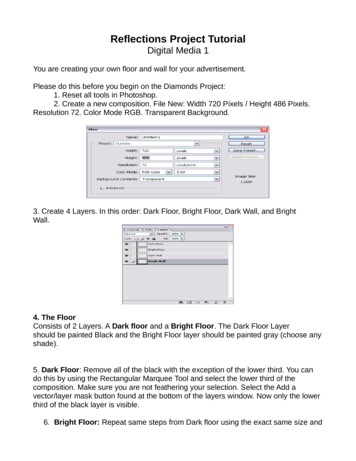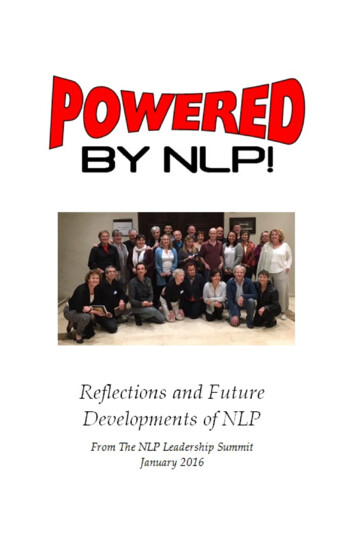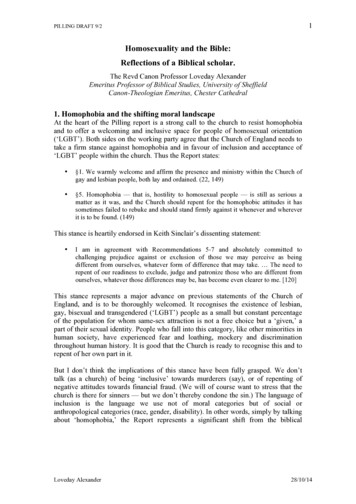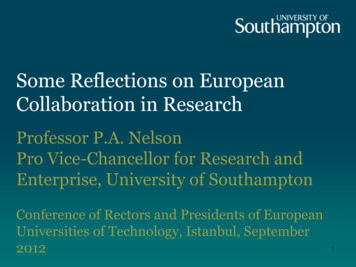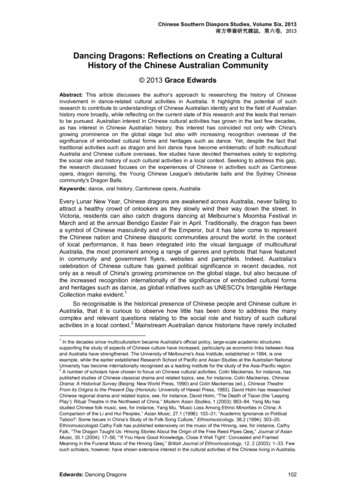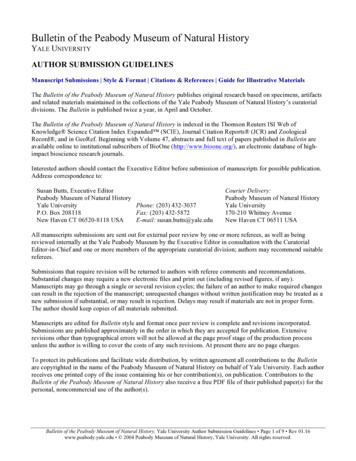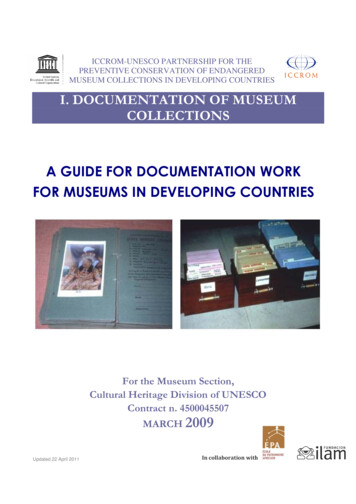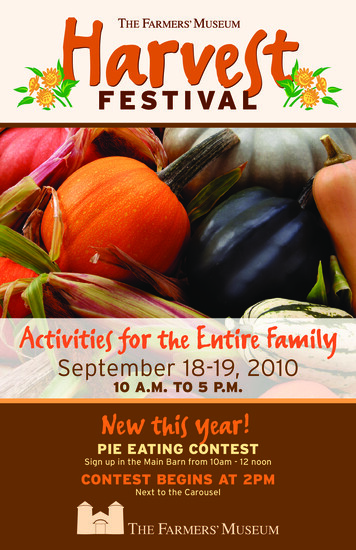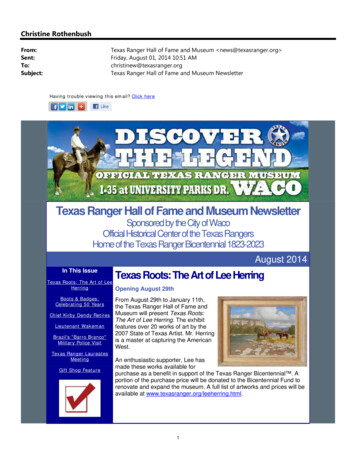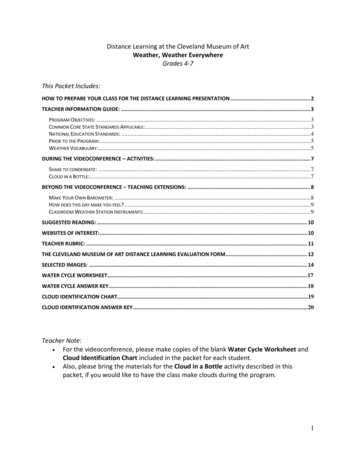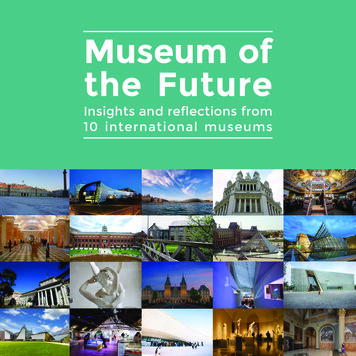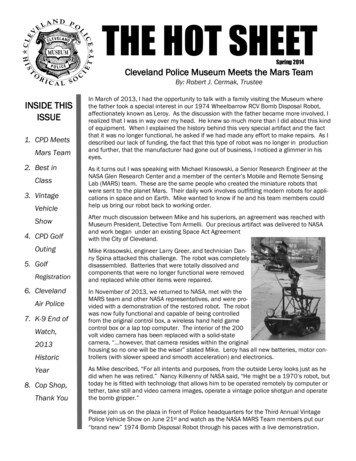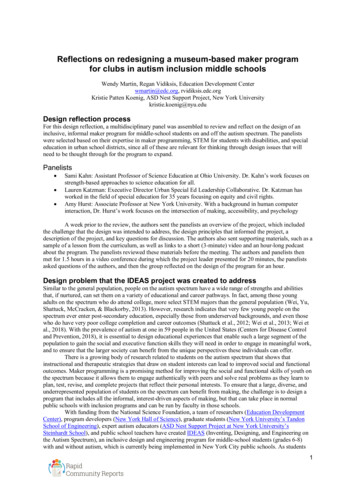
Transcription
Reflections on redesigning a museum-based maker programfor clubs in autism inclusion middle schoolsWendy Martin, Regan Vidiksis, Education Development Centerwmartin@edc.org, rvidiksis.edc.orgKristie Patten Koenig, ASD Nest Support Project, New York Universitykristie.koenig@nyu.eduDesign reflection processFor this design reflection, a multidisciplinary panel was assembled to review and reflect on the design of aninclusive, informal maker program for middle-school students on and off the autism spectrum. The panelistswere selected based on their expertise in maker programming, STEM for students with disabilities, and specialeducation in urban school districts, since all of these are relevant for thinking through design issues that willneed to be thought through for the program to expand.Panelists Sami Kahn: Assistant Professor of Science Education at Ohio University. Dr. Kahn’s work focuses onstrength-based approaches to science education for all.Lauren Katzman: Executive Director Urban Special Ed Leadership Collaborative. Dr. Katzman hasworked in the field of special education for 35 years focusing on equity and civil rights.Amy Hurst: Associate Professor at New York University. With a background in human computerinteraction, Dr. Hurst’s work focuses on the intersection of making, accessibility, and psychologyA week prior to the review, the authors sent the panelists an overview of the project, which includedthe challenge that the design was intended to address, the design principles that informed the project, adescription of the project, and key questions for discussion. The authors also sent supporting materials, such as asample of a lesson from the curriculum, as well as links to a short (3-minute) video and an hour-long podcastabout the program. The panelists reviewed these materials before the meeting. The authors and panelists thenmet for 1.5 hours in a video conference during which the project leader presented for 20 minutes, the panelistsasked questions of the authors, and then the group reflected on the design of the program for an hour.Design problem that the IDEAS project was created to addressSimilar to the general population, people on the autism spectrum have a wide range of strengths and abilitiesthat, if nurtured, can set them on a variety of educational and career pathways. In fact, among those youngadults on the spectrum who do attend college, more select STEM majors than the general population (Wei, Yu,Shattuck, McCracken, & Blackorby, 2013). However, research indicates that very few young people on thespectrum ever enter post-secondary education, especially those from underserved backgrounds, and even thosewho do have very poor college completion and career outcomes (Shattuck et al., 2012; Wei et al., 2013; Wei etal., 2018). With the prevalence of autism at one in 59 people in the United States (Centers for Disease Controland Prevention, 2018), it is essential to design educational experiences that enable such a large segment of thepopulation to gain the social and executive function skills they will need in order to engage in meaningful work,and to ensure that the larger society can benefit from the unique perspectives these individuals can offer.There is a growing body of research related to students on the autism spectrum that shows thatinstructional and therapeutic strategies that draw on student interests can lead to improved social and functionaloutcomes. Maker programming is a promising method for improving the social and functional skills of youth onthe spectrum because it allows them to engage authentically with peers and solve real problems as they learn toplan, test, revise, and complete projects that reflect their personal interests. To ensure that a large, diverse, andunderrepresented population of students on the spectrum can benefit from making, the challenge is to design aprogram that includes all the informal, interest-driven aspects of making, but that can take place in normalpublic schools with inclusion programs and can be run by faculty in those schools.With funding from the National Science Foundation, a team of researchers (Education DevelopmentCenter), program developers (New York Hall of Science), graduate students (New York University’s TandonSchool of Engineering), expert autism educators (ASD Nest Support Project at New York University’sSteinhardt School), and public school teachers have created IDEAS (Inventing, Designing, and Engineering onthe Autism Spectrum), an inclusive design and engineering program for middle-school students (grades 6-8)with and without autism, which is currently being implemented in New York City public schools. As students1
engage in the engineering design process around projects based on their personal interests, our expectation isthat they are developing the abilities and motivation necessary to pursue higher education and careers inengineering and design while also increasing the nature and quality of peer social interactions.Design Principles We used a collaborative co-design approach to adapt the New York Hall of Science (NYSCI)’s 3DDesign and Fabrication curriculum for use in inclusive middle-school clubs. From the very beginning,all stakeholders were involved in the adaptation process: special education and science teachers whowork in the Nest autism inclusion schools and members of NYU’s ASD Nest Support project, theNYSCI maker educators and NYU engineering graduate students and faculty, as well as the EDCresearch team. Teachers and administrators at the pilot schools determined what would work giventheir schools’ resources, culture, and constraints, and we adapted the program to meet those needs.In alignment with the ASD Nest program’s therapeutic model, we took a strengths-based approach toworking with students on the spectrum. This means that the focus is not on students’ deficits, buthelping students follow their own interests and encouraging them to build on what they do well and/orwhat they enjoy doing.Because we recognized the value of building shared understanding of maker education and autisminclusion techniques, the NYSCI staff provided training to the rest of the team in maker programmingand the particular 3D Design and Fabrication program we adapted, and the EDC, NYSCI andengineering grad students participated in an ASD Nest workshop.In years one and two of the project, we engaged in iterative pilot testing and revision of the adaptedprogram with students in participating schools. During the first year, the program was facilitated by aNYSCI maker educator, with help from teachers and engineering grad students. The program wasrevised based on that experience. During the second year of pilot testing, the program was led by theteachers with support from engineering graduate students and was again revised. In this final year, theprogram is being facilitated solely by the teachers.The Adapted ProgramThe IDEAS program, which is offered in schools as an afterschool, lunchtime, or elective club, takes studentsthrough a series of skill-building activities that allow students to acquire new skills and a series of applicationactivities that offer students the opportunity to apply the skills they previously learned, culminating in the use ofa 3D printer to complete a final project that is based on each student’s strengths and special interests. Studentsengage in the engineering design process (EDP) throughout the entire program. Some of the adaptations that wemade to the original NYSCI program to make it more appropriate for school clubs included (1) breaking longactivities into smaller components to fit within the time constraints of school club settings; (2) providing Makerclub teacher facilitators with tips and coaching on how to facilitate a 3D engineering and design club for a groupof students of mixed ages and abilities, highlighting the ways in which it differs from teaching an academicclass during the regular school day; (3) adding facilitation techniques for supporting children on the autismspectrum, such as accommodating for differences in students’ sensory processing and executive function; and(4) simplifying the materials used so that they can be easily purchased by the schools.Figure 1: Sample activity lesson plan2
Figure 2: Engineering design process modelFigure 3: Paper circuits activityFigure 4: Vibrating motors activity3
Figure 5: Sample Final ProjectResearch FindingsYouth on the spectrum tend to have difficulty socializing with peers, in particular, initiating interactions. One ofthe goals of the program was to create an environment in which these youth had something compelling to talkabout with others, to build their confidence and social skills. Pilot studies indicate that students with autismshowed a high level (over 50% of the time) of social initiations that included (1) asking for help from theirpeers, (2) direct questioning of their peers for information about their projects, (3) initiation of spontaneousconversations while working on Maker activities, and (4) increased social initiations with students withoutautism. These rates were even higher than the general education students. Project stakeholders also witnessedthe passion and dedication of many students, both on and off the autism spectrum, as they engaged with theirpeers in Making around their interests.During this final year of the project, the team is conducting a research study to investigate whether theprogram can be implemented sustainably in New York City autism inclusion schools, whether it shows promisefor helping students with autism spectrum disorder and their general education peers understand and engage inthe engineering design process, if it increases their science and engineering interest and career motivation, and ifit increases the nature and quality of their social interactions. The team has disseminated information about thisproject through different media, including a feature on Maker Ed and Autism on the podcast No Such Thing, anNSF STEM for All video showcase video, and numerous presentations at conferences, including theInternational Society for Autism Research and The Council for Exceptional Children.Key QuestionsOur team believes that the IDEAS Maker Program and the design process we used to develop it is a promisingapproach for creating new opportunities that help students on the autism spectrum engage productively withpeers around their interests to gain the social and executive function skills necessary for college and careers. Wereached out to the three panelists because of their expertise in urban special education, science education forstudents with disabilities, and designing making programing for urban youth. Our discussion focused on thefollowing questions: What program design issues do we need to consider in order to expand this program, and the use ofmaking more generally, to other districts, other age groups, and other contexts, and with otherpopulations of underrepresented students? How can we design the program to deepen connections between students’ academic STEM experiencesand the making experiences, while still connecting to their interests (for example, by building towardmore rigorous content in the informal program and/or infusing more making experiences into theacademic courses)? What professional development experiences do we need to design for teachers who were not directlyinvolved in the design of the program to enable them to implement a maker club at their school?4
Panelist FeedbackThe panel was asked to provide feedback on both the design of the program, and the design of the collaborativeco-design research process that was used to create it.Positive aspects of the designThe panel saw the design of the program as high quality because: It was designed to focus on students’ strengths rather than their deficits. It gives teachers a chance tosee what students are capable of outside of the academic setting and specific academic requirements. Many of the design features that were included to support students on the autism spectrum in makerand engineering activities actually reflect universal design features, such as encouraging students toengage and express themselves in different ways, being multi-modal and hands-on, and having teacherspresent material in different ways. There is a clear mapping between the steps of the engineering design process and skills related toexecutive function, which are skills that all students, but particularly students on the autism spectrum,need to build. For example, the “making a plan” EDP step is related to planning/prioritizing andorganization, and the iterative process of creating, testing, and revising prototypes can developflexibility and goal-directed persistence. The activities currently in the program have the potential to connect to middle school level NextGeneration Science Standards.Positive aspects of the researchThe panel saw the design of the research process as high quality because: It recognized and supported the role of the teacher as critical to adapting the activity for studentdifferences. Teachers and school administrators were involved from the beginning in adapting theprogram to work in school-based clubs. It used social interactions among participants as a measure of program value along with othermeasures.Program components in need of improvementThe panel recommended the following changes or additions: The panel noted that strengths are different from interests and that to take a strengths-based approach itis important to understand what students’ STEM strengths are. The panel suggested the design of aresearch instrument that would allow us to look systematically at what the strengths are that students ingeneral, but particularly students on the autism spectrum, bring to these STEM activities. Such aninstrument could then be applied more broadly in STEM education and could also substantiate thisproject’s claims that students’ strengths are particularly well-suited for making. The panel wanted the research to be designed to tease out what are the unique aspects of making inparticular that are effective for some students who might need more time or different entry points orobjectives to be successful. (For example, maybe the key factor is that the program is facilitated andnot taught; maybe the key is that making requires problem solving, iteration, and resilience; maybe animportant aspect of making is that students are allowed to socialize and build community with theirpeers.) This information could help teachers see certain characteristics as strengths rather than deficits,for example, reframing hyper-focus (seen as a deficit in students on the autism spectrum) as persistence(a positive trait), especially in the context of a making environment, which allows students morefreedom to demonstrate different ways of achieving goals than a typical academic environment. The panel encouraged us to reframe the messaging for this program as universal design for learning’,rather than as specifically for students on the autism spectrum or for autism inclusion settings. The goalis to make any science curriculum accessible for any student. The trend in special education now is toget away from narrow programs for specific disabilities and move to broader programs that work for awide range of students and abilities. They felt that in many ways the program itself has universaldesign elements (for example, enhancements that were made to the program, such as visual supportsand checklists, could benefit many different students) and that the messaging around the programshould be that it is inclusive, not focused on autism particularly. The panel observed that, while it was valuable to include teachers in the co-design process, it is just asimportant to include students in the co-design process. This means more than just having students5
involved in the pilot testing. They need to be involved in giving iterative feedback on the activities.This will be particularly important if we expand the program to high school.Potential next stepsThe panel saw ways to take the design into new territory, such as: Reaching out to pre-service teachers and teacher education programs. Many states now have a mandatefor teachers to earn dual certifications in special and general education, and this kind of program is onethat brings different disciplines together. The program could be adapted for pre-service teachers to useduring their classroom placements. Reaching new districts by creating a series of PD videos about how to facilitate the program, and howto connect to maker resources in local communities. The panel stressed, however, not to let districts seethis as PD only for special educators, but for all educators. Integrating the program into classroom instruction by strengthening the core content in the programand making explicit connections between the program and state or national science standards so thatdistricts can see how this approach can help them achieve instructional science and engineering goalsfor students with and without disabilities. Bringing the program to older students by connecting making to real world problems. The currentprogram helps students build foundational skills, but we need to think through what students can thendo with these skills to achieve more complex goals. Enhancing the workforce development potential of the program by connecting with companies that do3D printing and fabrication, organizations like American Association for the Advancement of Sciencewhich has relationships with STEM industries, and with organizations and institutions such asUniversity of New Hampshire that focus on transition services for students with disabilities.DiscussionThe feedback from the panelists was valuable in thinking through what is required to move the programforward. One important first step is to re-examine the messaging, and how to ensure that the program is notpresented or perceived as primarily for students on the autism spectrum, but for all students. We’ve evenconsidered changing the name going forward, from IDEAS: Inventing, designing, and engineering on the autismspectrum, to IDEAS: Inventing, designing, and engineering for all students. This is not only a “branding”change, but is based on what we have seen in the project, which is that those supports that were createdparticularly with students on the spectrum in mind, such as checklists and visual prompts and models of theEDP, are in no way exclusively beneficial for that group of students, but for many students with and without arange of disabilities.Another important piece of feedback that we have already started to act upon is to reach out topreservice colleges. We have been in discussion with a representative from Touro College, where many preservice teachers in New York City obtain their degrees. They are having an event for pre-service teachers thisspring that focuses on autism, and have invited members of this team to attend. We hope this will lead topossible future pre-service co-design efforts. This will necessarily require us to think about how to show explicitconnections to standards to achieve instructional goals if they were to use it in student teaching.Finally, feedback from the panel about understanding what it is particularly about making that maypromote student strengths, and about involving students more in the co-design process, has made us rethink ourfinal round of data collection for the spring. We plan to include questions in the student interview that probemore deeply about whether and how this experience is different from what they do in school, how the work theydid was related to their interests, and how they might change the activities to make them better. Movingforward, if we are able to scale up the program, we will seek to involve students more fully from the beginning,especially if we scale up to a high school program.ReferencesShattuck,
Kristie Patten Koenig, ASD Nest Support Project, New York University kristie.koenig@nyu.edu Design reflection process For this design reflection, a multidisciplinary panel was assembled to review and reflect on the design of an inclusive, informal maker program for middle-scho
